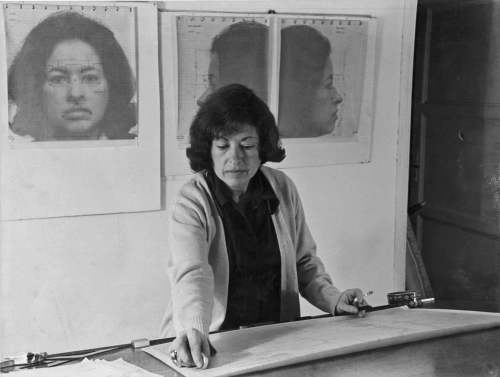
Teresa Burga, c.1972. Courtesy: Galerie Barbara Thumm.
Alexander Gray Associates is pleased to announce representation of Teresa Burga. A pioneering figure in Latin American Conceptualism, since the 1960s Burga has made works that encompass drawing, painting, sculpture, and conceptual structures that support the display of analytical data and experimental methodologies.
Born in Iquitos, Peru in 1935, Teresa Burga studied at the School of Art Catholic University of Peru in Lima and contributed significantly to the Peruvian avant-garde art scene at the time. In 1966, along with other forward-thinking artists in Lima, Burga formed part of the Arte Nuevo group, a collective of artists interested in advancing genres of Pop, Minimalism, Op Art, and happenings in Peru. Notably, the group only included two women artists––Burga and Gloria Gómez-Sánchez––indicative of the social barriers for women in the country in that moment, a subject that would influence Burga’s practice for decades. Prompted by a Fulbright scholarship, in 1968 Burga traveled to the United States and for two years studied at the Art Institute of Chicago. During this time of formal experimentation, Burga made works that questioned traditional artistic authorship, instead prioritizing conceptual prompts. Meant to be produced and replicated by anyone via highly-detailed schematic diagrams, her boldly-saturated Prismas sculptures, for example, embody both Pop and commercial aesthetics with colorful geometric forms. In other works, like Pictures with a Limited Time (1970) and Work That Disappears When the Spectator Tries to Approach It (1970), Burga invented immersive situations where spectators must activate the environment through the use of their own bodies.
In 1971, Burga returned to an authoritarian Peru, under the military rule of Juan Velasco Alvarado and his reformist government. Facing a repressive regime which did not favor Conceptual art, Burga pursued a career in Peru’s General Customs Office, where she would remain an official for three decades, designing solutions to enhance administrative efficiency in digital information systems. Throughout this time, Burga continued to make work that reflected the socio-political realities of the country: in particular, how standardized, regulated, and beaurocratic systems function as apparatuses for control and oppression––most saliently for women. Autorretrato. Estructura. Informe, 9.6.1972 (1972), for example, consists of a thorough portrait of Burga’s own body illustrated through medical reports, an audio simulation of her heartbeat, photographs, and various diagrams outlining biological data. Following a similar conceptual vein, in 1980 Burga developed Perfil de la mujer Peruana (Profile of the Peruvian Woman) (1980–81), an ambitious large-scale research project and installation. For the project, in collaboration with sociologist Marie-France Cathelat, Burga interviewed 290 women in Lima and recorded statistical data about their height, weight, religious identities, and political affiliations, among other categories, and displayed the findings using conceptual visual representations like a mannequin, a jigsaw puzzle, and various drawings.
In recent drawing series, Burga affirms her commitment to the destabilization of ubiquitous and singular authorship by appropriating subject matter from newspaper clippings and children’s drawings. As she explains, “ I want to escape from the artist’s taste and from subjective self-abstraction, because the worst thing an artist can do is to be self-complacent and please the public. I’ve always believed that.”
Teresa Burga’s work has been the subject of numerous solo exhibitions, including Teresa Burga at Kestner Gesellschaft, Hannover, Germany (2019); Aleatory Structures at Migros Museum, Zurich, Switzerland (2018); Teresa Burga: An Artist or a Computer?, at the Stedelijk Museum voor Actuele Kunst (SMAK), Ghent, Belgium (2018); Mano Mal Dibujada, Sculpture Center, New York, NY (2017); Estructuras de aire, MALBA, Buenos Aires, Argentina (2015); Die Chronologie der Teresa Burga. Berichte, Diagramme, Intervalle. 29.9.11, Württembergischen Kunstvereins Stuttgart, Germany (2011); Teresa Burga. Informes. Esquemas. Intervalos. 17.9.10., Instituto Cultural Peruano Norteamericano (ICPNA), Lima, Peru (2010); and Cuatro Mensajes, Instituto Cultural Peruano Norteamericano (ICPNA), Lima, Peru (1974). She has also participated in many group shows, including Radical Women: Latin American Art, 1960–1985, Hammer Museum, Los Angeles, CA (2017), which traveled to the Brooklyn Museum, New York, NY (2018) and Pinacoteca do Estado de São Paulo, Brazil (2018); Memories of Underdevelopment: Art and the Decolonial Turn in Latin America, Museo Jumex, Mexico City (2018) and Museum of Contemporary Art San Diego, CA (2018); A Kingdom of Hours, Gasworks, London, UK (2016); the 56th Venice Biennale, All the World’s Futures, curated by Okwui Enwezor (2015); The New Contemporary, Art Institute of Chicago, IL (2015); The World Goes Pop, Tate Modern, London, UK (2015); and the 12th Instanbul Biennial, Turkey (2011).
Burga’s work is featured in many private and public collections, including the Migros Museum, Zurich, Switzerland; Pinault Collection, Venice, Italy; Museum van Hedendaagse Kunst Antwerpen (M HKA), Antwerp, Belgium; Museo de Arte de Lima (MALI), Lima, Peru; Museo de Arte Latinoamericano de Buenos Aires (MALBA), Argentina; Pérez Art Museum Miami (PAMM), Miami, FL; Art Institute of Chicago, IL; Museum Ludwig, Cologne, Germany; Collection Hochschild, Lima, Peru; Sammlung Verbund Collection, Vienna, Austria; Thyssen-Bornemisza Art Contemporary Collection, Vienna, Austria; among others.
Teresa Burga is also represented by Galerie Barbara Thumm, Berlin.